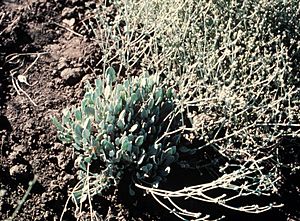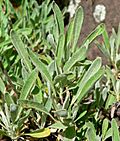Snow buckwheat facts for kids
Quick facts for kids Snow buckwheat |
|
|---|---|
 |
|
| Conservation status | |
| Scientific classification | |
| Genus: |
Eriogonum
|
| Species: |
niveum
|
Eriogonum niveum is a beautiful flowering plant often called snow buckwheat. It belongs to the buckwheat family. You can find this plant growing naturally in the Pacific Northwest region of North America. This includes places like British Columbia in Canada, and the states of Washington, Oregon, and Idaho in the United States.
Contents
Meet the Snow Buckwheat!
This wild buckwheat plant can look quite different from one place to another. It usually has stems that grow straight up, but sometimes they can spread out along the ground. It often forms a fuzzy, mat-like shape, usually about 40 to 60 centimeters (16 to 24 inches) tall and wide. Sometimes, it can even grow as big as one meter (about 3 feet) tall and wide!
Most of its leaves grow in a bunch at the woody base of the plant. These leaves can be up to 6 centimeters (about 2.4 inches) long and feel soft and woolly. The plant's flowers grow in clusters on branching stems. These tiny flowers can be white, pink, or even reddish.
Traditional Uses
Long ago, some Native American groups used the snow buckwheat plant for health. They found ways to use it to help with things like colds and cuts. The roots of this plant, along with a related plant called Eriogonum heracleoides, were sometimes made into a special tea. This tea was used to help with tummy troubles like diarrhea.
Where Does It Grow?
Snow buckwheat likes to grow in open, sunny places. You can find it in grassy plains, dry sagebrush deserts, and in forests where ponderosa pine trees grow. It mostly lives east of the Cascade Range mountains.
This plant is known as a "pioneer species." This means it's one of the first plants to grow in thin, dry soils where other plants haven't started growing yet. It's tough and can help prepare the ground for other plants to follow. Other plants that might grow nearby include Artemisia tridentata (sagebrush), Purshia tridentata (bitterbrush), and various types of grasses.
Helping the Earth
People can also grow snow buckwheat on purpose. It's a great plant for areas with very little soil, like places where mining has happened. It can help the soil become more stable. This plant is also useful in xeriscaping, which is a way of gardening that uses plants that don't need much water. There's even a special type of snow buckwheat called 'Umatilla' that is used to help restore rangelands and stop soil from washing away.
Wildlife Friends
In the wild, snow buckwheat provides food for different animals. Mule deer and bighorn sheep enjoy munching on this plant. It's also a food source for a special and rare insect called the Mormon metalmark butterfly.



